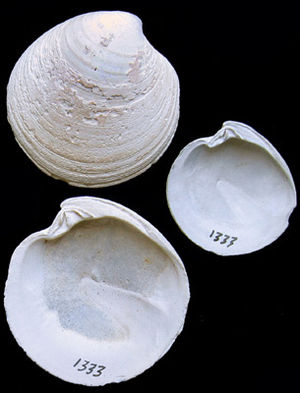Smooth Artemis
| Smooth Artemis | ||||||||||||
|---|---|---|---|---|---|---|---|---|---|---|---|---|

Dosinia lupinus (Linnaeus, 1758) |
||||||||||||
| Systematics | ||||||||||||
|
||||||||||||
| Scientific name | ||||||||||||
| Dosinia lupinus | ||||||||||||
| ( Linnaeus , 1758) |
The Smooth Artemis ( Dosinia lupinus ), also called Helle Artemis , is a type of mussel from the order of the Venerida .
features
The rounded, elliptical case , which has the same flaps, measures around 3.8 cm in diameter. The vertical axis is slightly larger than the horizontal axis. It's relatively flat, i.e. H. the two valves are moderately arched outwards (inflated). It is slightly unequal, the vertebrae sit a little in front of the center line (based on the length of the case). The vertebrae are bent forward (prosogyr). The lunula is clearly separated with a radial back, but quite short. The lock has three cardinal teeth in both flaps. In the left valve there is also a small lateral tooth in front of the first cardinal tooth. The deeply sunken ligament extends over about half the length of the posterior dorsal margin. The inner edge of the case is smooth. The surface line shows a deep and narrow bay. The siphons are quite long and grown together.
The shell is strong. The surface shows only fine concentric ribs and streaking growth. The color of the outside varies from pale yellow to off-white. Occasionally beige radial rays emanate from the vertebrae. The periostracum is a thin pale yellow coating.
Similar species
The Artemis Shell ( Dosinia exoleta ) is slightly more rounded in outline and also slightly larger than the Smooth Artemis. The surface of the smooth Artemis case is glossy, whereas the surface of the Artemis shell is rather matte. The outside is more ribbed and the ligament is slightly shorter.
Geographical distribution, habitat and way of life
The smooth Artemis occurs in the eastern Atlantic from Norway to West Africa, including the North Sea and the Mediterranean.
It lives buried in sandy-silty, coarse-sanded to gravelly shell-fracture substrates from the tidal range to about 270 meters water depth.
Taxonomy
The taxon was first described by Carl von Linné in 1758 as Venus lupinus . It is now generally accepted as belonging to the genus Dosinia Scopoli, 1777.
supporting documents
literature
- Fritz Gosselck, Alexander Darr, Jürgen HJ Jungbluth, Michael Zettler: common names for mollusks of the sea and brackish water in Germany. Mollusca, 27 (1): 3-32, 2009 PDF
- Fritz Nordsieck: The European sea shells (Bivalvia). From the Arctic Ocean to Cape Verde, the Mediterranean Sea and the Black Sea. 256 pages, Gustav Fischer Verlag, Stuttgart 1969
- Guido Poppe. Yoshihiro Goto: European Seashells Volume 2 (Scaphopoda, Bivalvia, Cephalopoda) . 221 pp., Verlag Christa Hemmen, Wiesbaden 1993 (2000 unc. Reprint), ISBN 3925919104 (p. 122)
- Rainer Willmann: Mussels of the North and Baltic Seas. 310 p., Neumann-Neudamm, Melsungen 1989 ISBN 3-7888-0555-2 (p. 138)
On-line
Individual evidence
- ^ Carl von Linné: Systema naturæ per regna tria naturæ, secundum classes, ordines, genera, species, cum characteribus, differentiis, synonymis, locis. Tomus I. Editio decima, reformata. 1-824, Stockholm / Holmia, Salvius, 1758 Online at www.biodiversitylibrary.org (p. 689)
- ↑ MolluscaBase: Dosinia lupinus (Linnaeus, 1758)